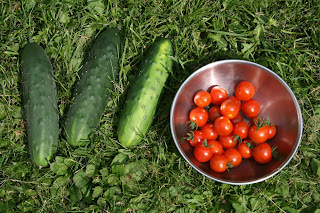In keeping with
our goals of Reduce, Reuse, Recycle, I decided to construct some sort of system
that would collect and make use of rainwater for the Thirty Square Foot Garden.
Humans have been collecting rainwater for millennia. Cisterns have been traced
back to at least 4,000 B.C. Only 2.5% of the Earth's water is freshwater, and
98.8% of that water is in ice and groundwater. So, freshwater is really a very precious
resource, and conserving it should be a goal for all of us.
The garage next to my garden had a rain collection gutter on it, but it was on the wrong side of the building, so my first task was to carefully disassemble it, clean out all of the muck from years of disuse, and then reassemble it on the garden side of the garage. This was pretty straight-forward and took about a day to complete.
Here is the reassembled rain gutter and downspout:
The next step was to procure some sort of rain barrel. While there are commercially available rain barrels, these are pretty pricey at between $100 and $200. If you do a little searching in your community, you may be able to find a suitable alternative. I was able to locate a food grade plastic 55 gallon drum for only $20. Apparently, these drums are used to transport apple juice concentrate, and amazingly, are only used once and then thrown away. So, this turned out to be an excellent example of recycling.
Converting the
drum to be a rain barrel was a fairly straight forward process. I purchased a
plastic hose shut-off valve for about $8. I drilled a 1" hole near the
bottom of the barrel, and using some silicon seal, screwed the shut-off into
the barrel. The top of the barrel already had two bung holes in it. I removed
one of the bungs, and secured some ¼" plastic screening over the hole to
keep debris from getting into the barrel. I also installed a leaf strainer at
the top of the downspout for this purpose.
The higher off
the ground, the more water pressure you will get, so I cut some old fence posts
into 2' lengths and made a simple platform that raised the barrel about
14". I used an 8" flex elbow to connect the downspout to the rain
barrel. Some rough calculations indicate that I should get somewhere between 2
and 3 psi of water pressure from this setup.
The downspout that
supplies my rain barrel is fed by about 150 square feet of roof, so has the
potential of about 75 gallons per inch of rainfall, using the following rule of
thumb: ½ gallon per square foot per inch of rain. Again, using some rough
calculations and the average rainfall figures for the summer months where I
live, I can expect to collect about 1,000 gallons of water over the course of
the gardening season. This is a conservative estimate. That is not too shabby!
Here is a breakdown of my costs for this project. Of course, my expenses were somewhat reduced because I already had the rain gutter and downspout materials.
Rain Barrel
Project:
|
|
50' Boat &
Camper Hose
|
19.20
|
Plastic Hose
Shut-off
|
7.90
|
Silicon Sealer
|
3.94
|
55 Gallon Drum -
Food Grade Plastic
|
20.00
|
10-Pattern Hose
Nozzle
|
10.16
|
8" Flex Elbow
|
6.77
|
3" Leaf
Strainer
|
3.94
|
Brass Hose Repair
Coupling - Male End
|
3.27
|
Total
cost:
|
$75.18
|
The final result
is a simple, low tech solution to watering my garden for the season which
allows me to reduce my water bill, reuse the barrel, rain gutter,
and downspout materials, and recycle the rainwater for a very useful
purpose. Now, I am waiting for it to rain!













